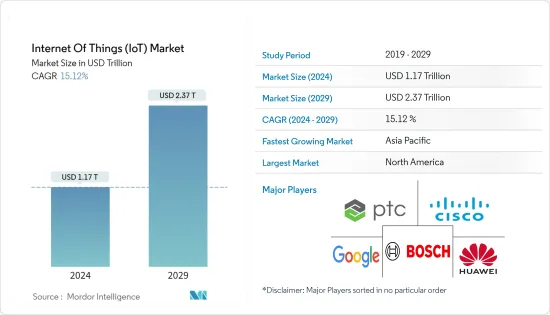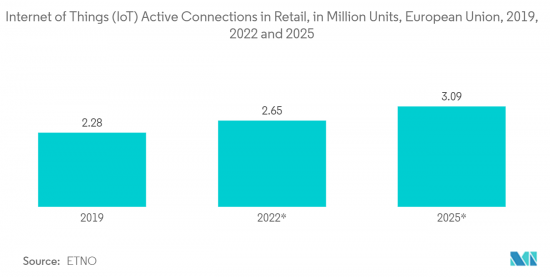 |
市场调查报告书
商品编码
1403099
物联网 (IoT):市场占有率分析、产业趋势与统计、2024-2029 年成长预测Internet Of Things (IoT) - Market Share Analysis, Industry Trends & Statistics, Growth Forecasts 2024 - 2029 |
||||||
※ 本网页内容可能与最新版本有所差异。详细情况请与我们联繫。
物联网市场规模预计到 2024 年为 1.17 兆美元,预计到 2029 年将达到 2.37 兆美元,在预测期内(2024-2029 年)复合年增长率为 15.12%。

在 COVID-19 大流行期间,市场供应商正在与多个组织合作,提供新技术支援的解决方案,以帮助医疗保健组织有效克服危机。例如,1 月下旬,上海公共卫生临床中心 (SPHCC) 开始使用加州互联连线健诊新兴企业VivaLNK 的连续体温测量设备来监测 COVID-19 患者,使看护者面临暴露于病毒的风险。减少。
主要亮点
- 物联网技术是各种组织数位转型的基石,使他们能够建立和追踪新的业务模型以及升级现有流程。企业和服务供应商将物联网视为加强数位转型和提高业务效率的关键推动因素。物联网技术在製造、汽车和医疗保健等最终用户行业中的日益采用正在积极推动市场成长。传统製造业正在经历数位转型,物联网正在推动智慧型互联的下一次工业革命。这正在改变行业处理系统和机械中日益复杂的流程的方式,以提高效率并减少停机时间。
- 工业 4.0 和物联网是整个物流链开发、生产和管理的新技术方法的核心,即智慧工厂自动化。随着工业4.0 和物联网(IoT) 的普及,製造业发生了巨大转变,正在推动向敏捷、智慧和创新技术的转变,透过机器人技术补充和增强人类劳动力,并透过减少工业事故的技术推动生产。流程失败,需要企业采取方法。随着连网型设备和感测器的高采用率以及 M2M通讯的可用性,製造中产生的资料点数量正在迅速增加。这些资料点可以是任何东西,从衡量材料经历一个加工週期所需时间的指标到计算汽车行业材料应力能力等复杂的数据。
- 根据 Zebra 的製造愿景研究,基于物联网和 RFID 的智慧资产追踪解决方案预计到 2022 年将取代基于电子表格的传统方法。根据工业IoT(IIoT) 公司 Microsoft 的一项研究,85% 的公司至少拥有一个 IIoT 用例计划。随着 94% 的受访者声称将在 2021 年实施 IIoT 策略,这一数字可能还会增加。
- 现场设备、感测器和机器人的进步预计将进一步扩大市场范围。物联网技术正在克服製造业的劳动力短缺问题。对于越来越多的组织来说,利用机器人化等工业 4.0 技术正在成为日常业务的一部分。根据国际机器人联合会预测,协作机器人市场预计两年内将达到123亿美元。智慧型机器人与工人一起工作,大多数工厂工人都可以对其进行编程,以承担最日常和最繁琐的任务并准确地交货。
- 机器人在製造业中的使用越来越多,因为它们易于训练,并且可以在潜在危险的情况下取代机器人,使职场环境对人类更安全。高度可训练和协作的机器人可以在危险或不合适的情况下取代人类,为人类提供更安全的职场环境。例如,采矿场使用的自动自卸自动卸货卡车可以由操作员远端控制,因此无需人类驾驶人。
物联网 (IoT) 市场趋势
零售业将经历显着成长
- 零售业正在增加商家和最终消费者对连网型设备的使用。电子商务的使用和可支配收入的增加正在支持超级市场和大卖场的成长。软体和数数位化的使用以及必要的互联网接入展现了物联网设备在市场类别中的市场潜力。
- 物联网预计也将在多个领域带来变革,例如补充仓储设施。包括三星和 LG 在内的主要电子製造商正在发布连网型冰箱等产品,这些产品可以自动重新订购起司或牛奶等缺货的产品。
- 此外,智慧型手机的普及和网路购物的便利性也增加了电子商务平台的使用。由于对资料分析和分析整合的需求不断增加,预计该市场将会成长。
- 零售商的物联网重要应用包括供应链、联网消费者和智慧商店应用。零售商正在转向支援物联网的解决方案来帮助提高客户参与、增加收益并降低成本。

北美实现显着成长
- 联网汽车、智慧型能源计划、家庭自动化以及对智慧製造的关注正在推动物联网在该地区主要收益终端用户产业中发挥越来越大的作用。北美可能是这方面的重要市场。该地区物联网的扩张也得益于各工业部门的快速数位化和技术突破。
- SAS Software 等公司推动的人工智慧和物联网整合是下一波基于物联网的人工智慧浪潮,是预计从正在改变美国製造业的当前技术中出现的未来技术之一。在美国,公共产业部门目前面临巨大压力。美国能源资讯署预测,儘管国内可再生能源生产大幅成长,但 2017 年全球能源需求仍将成长 48%。
- 该地区率先采用了基于容器的云端应用程序,为配置提供了弹性和效能。集中式或基于边缘的物联网部署正在逐渐习惯于基于容器的云端配置。例如,VMware发布了VMware Tanzu,这是一个控制Kubernetes容器分发的云端平台。
- 此外,该地区也是许多开发创新物联网晶片解决方案的新兴企业的所在地。例如,美国新兴企业Wiliot 基于无电池蓝牙技术创建物联网晶片,用于製造、材料回收、零售和资产分配。这些蓝牙标籤包含感测器、低功耗处理器和基于无线电波的能源采集电路。新兴企业使用的无电池技术的价格要低得多。
物联网 (IoT) 产业概述
物联网(IoT)市场竞争激烈,国内外市场有许多大大小小的公司。由于技术的高度存在,市场似乎是分散的。产品创新和併购是市场参与企业典型的两个重要手段。市场参与企业的主要例子包括甲骨文公司、思科系统公司、Google公司、IBM公司和微软公司。
2023年4月,高通宣布推出尖端物联网解决方案,支援新的工业应用并协助扩展物联网生态系统。最新的物联网解决方案为智慧建筑、企业、零售和工业自动化等各种物联网使用案例提供卓越的效能、先进的连接性和下一代处理能力。
2022 年 11 月,德克萨斯(TI) 宣布将为 Wi-Fi 和 Thread SimpleLink 无线微控制器 (MCU) 推出一款支援 Matter 的新软体开发套件,以简化Matter 协定在物联网(IoT) 应用中的采用。该软体以 TI 与连接标准联盟的密切合作以及 2.4GHz 连接领域的创新为基础。使用新的软体和无线 MCU,工程师可以创建超低功耗、安全、电池供电的智慧家庭和工业自动化物联网应用,这些应用可与独特生态系统中的设备无缝连接。
其他福利:
- Excel 格式的市场预测 (ME) 表
- 3 个月分析师支持
目录
第一章简介
- 研究假设和市场定义
- 调查范围
第二章调查方法
第三章执行摘要
第四章市场概况
- 市场概况
- 产业吸引力-波特五力分析
- 供应商的议价能力
- 买方议价能力
- 新进入者的威胁
- 替代品的威胁
- 竞争公司之间敌对关係的强度
- 产业价值链分析
- 法律规范
- 评估 COVID-19 对产业的影响
第五章市场动态
- 市场驱动因素
- 连网型设备的采用增加和技术的普及
- 资料分析的快速成长和技术进步
- 市场抑制因素
- 资料安全和隐私、设备连接和互通性问题
第 6 章 物联网使用案例
第七章市场区隔
- 按成分
- 硬体
- 软体/平台
- 连接性
- 服务
- 按最终用户产业
- 製造业
- 运输
- 卫生保健
- 零售
- 能源/公用事业
- 住宅产业
- 其他最终用户产业
- 按地区
- 北美洲
- 欧洲
- 亚太地区
- 拉丁美洲
- 中东/非洲
第八章竞争形势
- 公司简介
- Huawei Technologies Co. Ltd
- Robert Bosch GmbH
- Google Inc.
- Cisco Systems Inc.
- PTC Inc.
- Siemens AG
- Honeywell International Inc.
- Koninklijke Philips NV
- Aeris Communications Inc.
- Amazon Web Services Inc.
- IBM Corporation
- Microsoft Corporation
- General Electric Company
- Fujitsu Ltd
- Oracle Corporation
- SAP SE
- AT&T Inc.
- Wipro Ltd
第九章投资分析
第10章市场的未来

The Internet Of Things Market size is estimated at USD 1.17 trillion in 2024, and is expected to reach USD 2.37 trillion by 2029, growing at a CAGR of 15.12% during the forecast period (2024-2029).
During the COVID-19 pandemic, the vendors in the market are collaborating with several organizations to offer emerging technology-enabled solutions to healthcare organizations to help them overcome the crisis effectively. For instance, at the end of January, the Shanghai Public Health Clinical Center (SPHCC) used the California-based connected health startup VivaLNK's continuous temperature measuring device to monitor COVID-19 patients, reducing the risks of caregivers being exposed to the virus.
Key Highlights
- IoT technology is the keystone for various organizations to digitally transform, thus empowering them to upgrade the existing processes by creating and tracking new business models. Enterprises and service providers have considered IoT the key enabler to augment digital transformation and unlock operational efficiencies. The growing adoption of IoT technology across end-user industries, such as manufacturing, automotive, and healthcare, is positively driving the market's growth. With the traditional manufacturing sector amid a digital transformation, IoT is fueling the next industrial revolution of intelligent connectivity. This is changing how industries approach increasingly complex processes of systems and machines to improve efficiency and reduce downtime.
- Industry 4.0 and IoT are central to new technological approaches for developing, producing, and managing the entire logistics chain, otherwise known as smart factory automation. Massive shifts in manufacturing due to Industry 4.0 and the acceptance of IoT require enterprises to adopt agile, smarter, and innovative ways to advance production with technologies that complement and augment human labor with robotics and reduce industrial accidents caused by process failure. With the high rate of adoption of connected devices and sensors and the enabling of M2M communication, there has been a surge in data points generated in the manufacturing industry. These data points can be of various kinds, ranging from a metric describing the time taken for the material to pass through one process cycle to a more advanced one, such as calculating the material stress capability in the automotive industry.
- According to Zebra's Manufacturing Vision Study, smart asset tracking solutions based on IoT and RFID are expected to overtake traditional, spreadsheet-based methods by 2022. A study by the Industrial IoT (IIoT) company Microsoft Corporation found that 85% of companies have at least one IIoT use case project. This number may increase, as 94% of respondents claimed they would implement IIoT strategies in 2021.
- The advancements in field devices, sensors, and robots are expected to expand the scope of the market further. IoT technologies are overcoming the labor shortage in the manufacturing sector. For more and more organizations, using Industry 4.0 technologies, like robotization, is part of day-to-day operations. According to the International Federation of Robotics, the market for collaborative robots is expected to reach USD 12.3 billion in two years. Intelligent robots work alongside workers and can be programmed by most factory workers to take on the most routine, tedious tasks and deliver accurately.
- They are increasingly used in the manufacturing industry as they are easy to train and make workplace environments safer for humans by taking their place in potentially dangerous situations. Highly trainable and collaborative, robots also deliver safer working environments for humans by switching places with them in dangerous or unsuitable situations. For instance, autonomous dump trucks used at mining sites can be remotely controlled by operators, eliminating the need for human drivers.
Internet of Things (IoT) Market Trends
The Retail Segment to Witness a Significant Growth
- Both merchants and the end consumers it serves have boosted their use of connected devices in the retail industry. The use of e-commerce and the rise in disposable income support the growth of supermarkets and hypermarkets. The usage of software and digitalization, along with the required internet access, presents a market potential for IoT devices in the market category.
- IoT is also anticipated to transition significantly in several domains, including replenishing inventory in storage facilities. Major electronics producers are releasing products like connected refrigerators that can automatically reorder cheese, milk, or any other item that is running low, including Samsung and LG.
- Moreover, there is an increase in the use of e-commerce platforms owing to the growing smartphone penetration and the ease of online shopping. Due to the increasing need for data analysis and analytics integration, the market is expected to grow.
- The critical applications of IoT for retailers include the supply chain, connected consumers, and smart-store applications. Retailers are turning to IoT-enabled solutions, as they help them improve customer engagement while increasing revenues and reducing costs.

North America to Witness a Significant Growth
- The deployment of connected vehicles, projects utilizing smart energy, home automation, and a focus on smart manufacturing are driving the expanding role of IoT among the region's crucial revenue-generating end-user industries. North America is likely a significant market in this regard. The expansion of IoT in this area has also been aided by fast digitalization across industry sectors and technological breakthroughs.
- The convergence of AI and IoT, promoted by firms like SAS Software as the next wave of IoT-based AI, is among the future technologies that are anticipated to arise out of the present technologies that are altering manufacturing in the United States. The utility sector is currently under intense pressure in the US. The US Energy Information Administration predicted worldwide energy demand will increase by 48% in 17 years, even though domestic energy production from renewable resources has expanded dramatically.
- The area is a pioneer in adopting container-based cloud applications that give deployments more flexibility and performance. Any centralized or edge IoT deployment is becoming accustomed to container-based cloud deployments. For instance, VMware introduced VMware Tanzu, a cloud platform that controls Kubernetes' container distribution.
- Additionally, the region is home to many startups developing ground-breaking IoT chip solutions. For example, a US startup, Wiliot, creates IoT chips based on Bluetooth technology without needing batteries for manufacturing, material recycling, retail, and asset distribution. These Bluetooth tags incorporate sensors, a low-power processor, and radio wave-based energy harvesting circuitry. The battery-free technology used by the startup offers much lower prices.
Internet of Things (IoT) Industry Overview
The Internet of Things (IoT) market is highly competitive owing to many large and small players operating in the domestic and international markets. Due to the high presence of technology, the market seems to be fragmented. Product innovation and mergers and acquisitions are two important methods the leading market participants use. Oracle Corporation, Cisco Systems Inc., Google Inc., IBM Corporation, and Microsoft Corporation are a few of the market's main participants.
In April 2023, Qualcomm introduced cutting-edge IoT solutions to enable new industrial applications and help scale the IoT ecosystem. The latest IoT solutions deliver superior performance, advanced connectivity, and next-gen processing for a wide range of IoT use cases for smart buildings, enterprises, retail, and industrial automation.
In November 2022, Texas Instruments (TI) introduced new Matter-enabled software development kits for Wi-Fi and Thread SimpleLink wireless microcontrollers (MCUs) that will streamline the adoption of the Matter protocol in the Internet of Things (IoT) applications. The software builds on TI's close involvement with the Connectivity Standards Alliance and innovation in the 2.4-GHz connectivity space, where engineers can use the new software and wireless MCUs to create ultra-low-power and secure, battery-powered smart home and industrial automation IoT applications that seamlessly connect with devices across proprietary ecosystems.
Additional Benefits:
- The market estimate (ME) sheet in Excel format
- 3 months of analyst support
TABLE OF CONTENTS
1 INTRODUCTION
- 1.1 Study Assumptions and Market Definition
- 1.2 Scope of the Study
2 RESEARCH METHODOLOGY
3 EXECUTIVE SUMMARY
4 MARKET INSIGTHS
- 4.1 Market Overview
- 4.2 Industry Attractiveness - Porter's Five Forces Analysis
- 4.2.1 Bargaining Power of Suppliers
- 4.2.2 Bargaining Power of Buyers
- 4.2.3 Threat of New Entrants
- 4.2.4 Threat of Substitute Products
- 4.2.5 Intensity of Competitive Rivalry
- 4.3 Industry Value Chain Analysis
- 4.4 Regulatory Framework
- 4.5 Assessment of the Impact of COVID-19 on the Industry
5 MARKET DYNAMICS
- 5.1 Market Drivers
- 5.1.1 Increasing Adoption of Connected Devices and Technology Proliferation
- 5.1.2 Rapid Growth and Technological Advancements in Data Analytics
- 5.2 Market Restraints
- 5.2.1 Issues Related to Security and Privacy of Data and Connectivity of Devices and Interoperability
6 USE CASES OF IoT
7 MARKET SEGMENTATION
- 7.1 By Component
- 7.1.1 Hardware
- 7.1.2 Software/Platform
- 7.1.3 Connectivity
- 7.1.4 Services
- 7.2 By End-user Industry
- 7.2.1 Manufacturing
- 7.2.2 Transportation
- 7.2.3 Healthcare
- 7.2.4 Retail
- 7.2.5 Energy and Utilities
- 7.2.6 Residential
- 7.2.7 Other End-user Industries
- 7.3 By Geography
- 7.3.1 North America
- 7.3.2 Europe
- 7.3.3 Asia Pacific
- 7.3.4 Latin America
- 7.3.5 Middle East and Africa
8 COMPETITIVE LANDSCAPE
- 8.1 Company Profiles
- 8.1.1 Huawei Technologies Co. Ltd
- 8.1.2 Robert Bosch GmbH
- 8.1.3 Google Inc.
- 8.1.4 Cisco Systems Inc.
- 8.1.5 PTC Inc.
- 8.1.6 Siemens AG
- 8.1.7 Honeywell International Inc.
- 8.1.8 Koninklijke Philips NV
- 8.1.9 Aeris Communications Inc.
- 8.1.10 Amazon Web Services Inc.
- 8.1.11 IBM Corporation
- 8.1.12 Microsoft Corporation
- 8.1.13 General Electric Company
- 8.1.14 Fujitsu Ltd
- 8.1.15 Oracle Corporation
- 8.1.16 SAP SE
- 8.1.17 AT&T Inc.
- 8.1.18 Wipro Ltd









